Abstract
OBJECTIVE: This study was undertaken to evaluate whether hematologic and immunologic effects observed after bacteremia and endotoxemia in the host could be replicated by administration of recombinant human interleukin-1 alpha (IL-1 alpha) in a primate model. Furthermore, to determine whether endogenously produced interleukin-1 (IL-1) contributes to the changes observed during endotoxemia or gram-negative septic shock, a specific IL-1 receptor antagonist (IL-1 ra) was administered. SUMMARY BACKGROUND DATA: The lipopolysaccharide (LPS) component of the outer membrane of gram-negative bacteria initiates a constellation of metabolic and immunologic host responses. IL-1, a macrophage-derived cytokine, acts as a key mediator in the host response to infection and inflammation. METHODS: Baboons were randomly assigned to receive either recombinant human IL-1 alpha, LPS, or live Escherichia coli both with or without concomitant administration of IL-1ra. Blood was collected hourly and analyzed using flow cytometric techniques. RESULTS: Both endotoxemia and live E. coli bacteremia induced an acute granulocytopenia; however, the granulocytopenia gradually resolved in the endotoxemic group, but was sustained in the bacteremic group. An early lymphopenia and monocytopenia was elicited by LPS or E. coli and persisted throughout the experiment. Recombinant human IL-1 alpha induced the following: (1) an early, transient decline in granulocytes followed by a sustained granulocytosis; (2) a lymphopenia; and (3) a transient monocytopenia followed by a gradual return to baseline. Although IL-1ra had no effect on leukocyte kinetics with either live E. coli or LPS, the IL-1ra significantly abrogated the monocytopenia seen with recombinant human IL-1 alpha administration alone. CONCLUSIONS: These results suggest that administration of recombinant human IL-1 alpha can replicate some of the characteristic patterns of hematologic change associated with bacteremia and endotoxemia. However, an endogenous IL-1 response is not required for these changes to occur. Rather, the data suggest that other inflammatory mediators induced by endotoxemia or gram-negative bacteremia, such as tumor necrosis factor-alpha (TNF alpha), may be involved.
Full text
PDF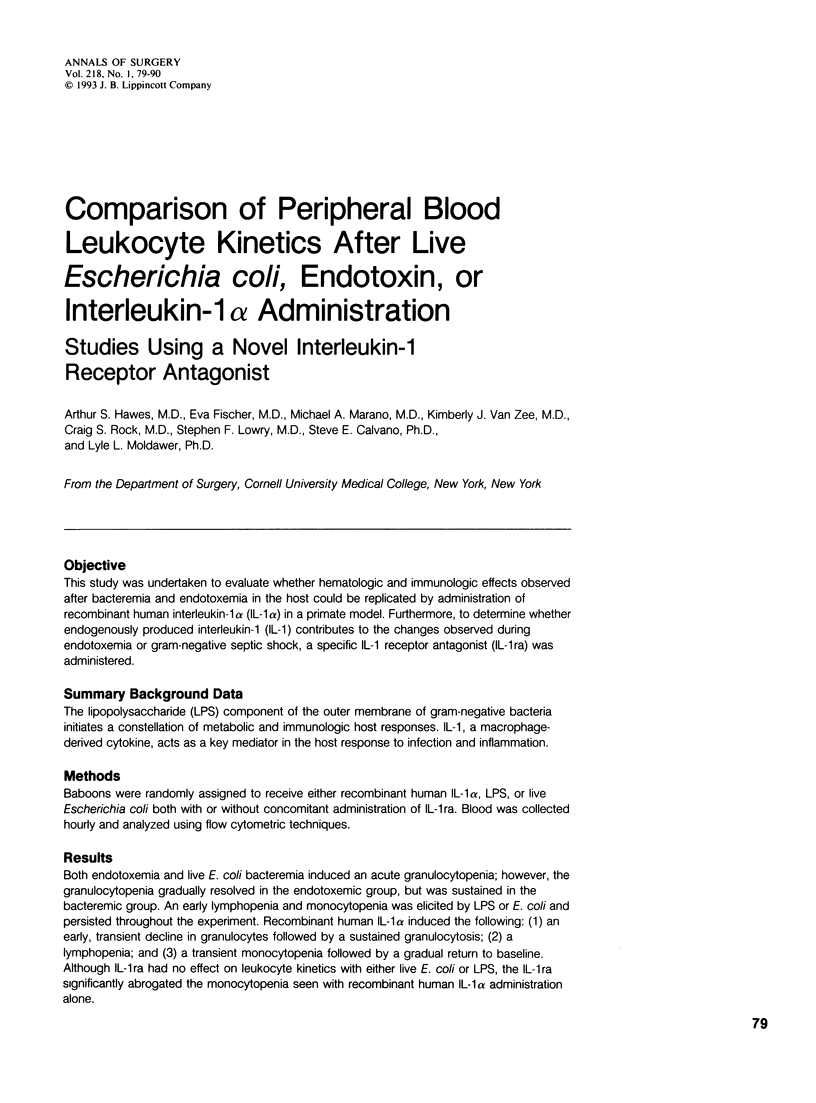
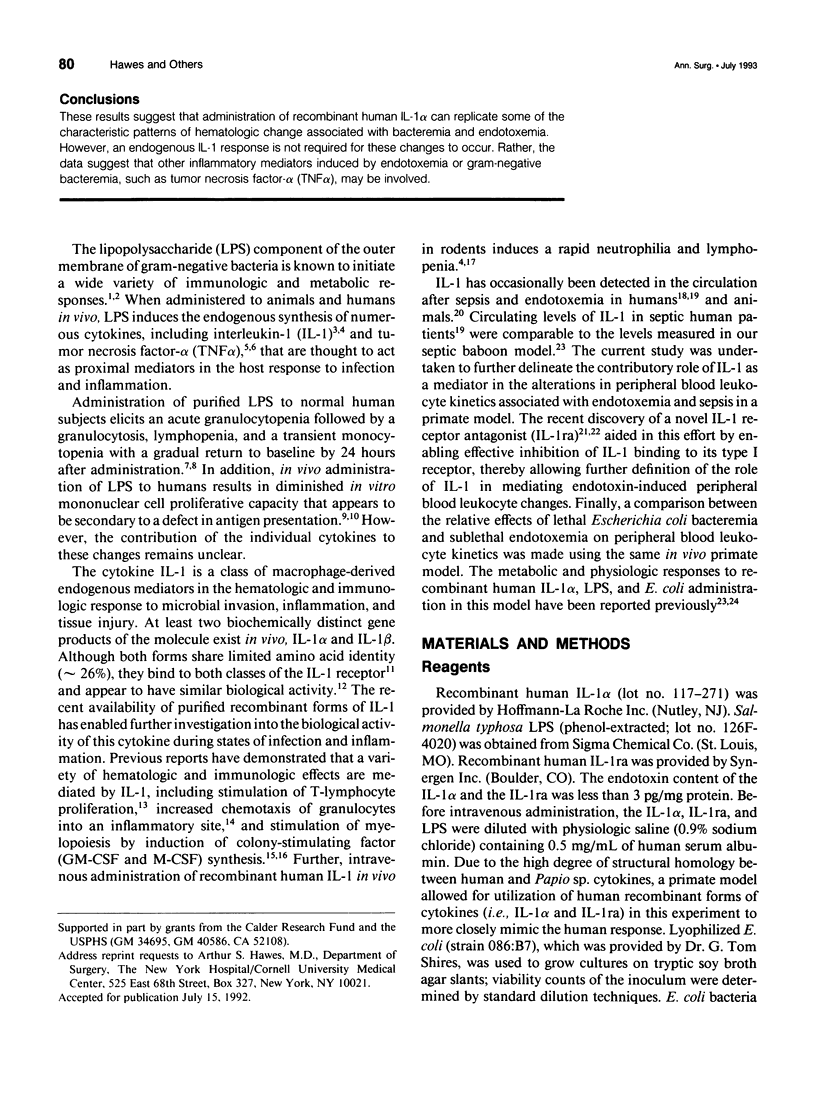
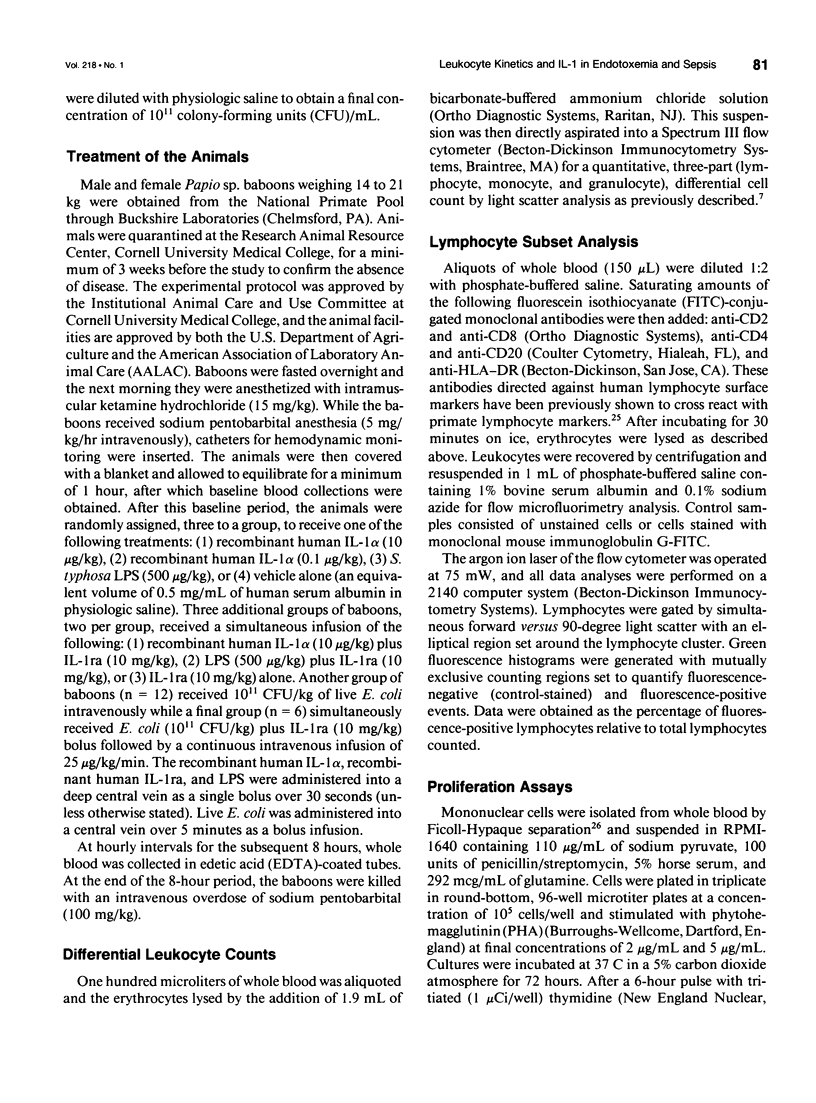
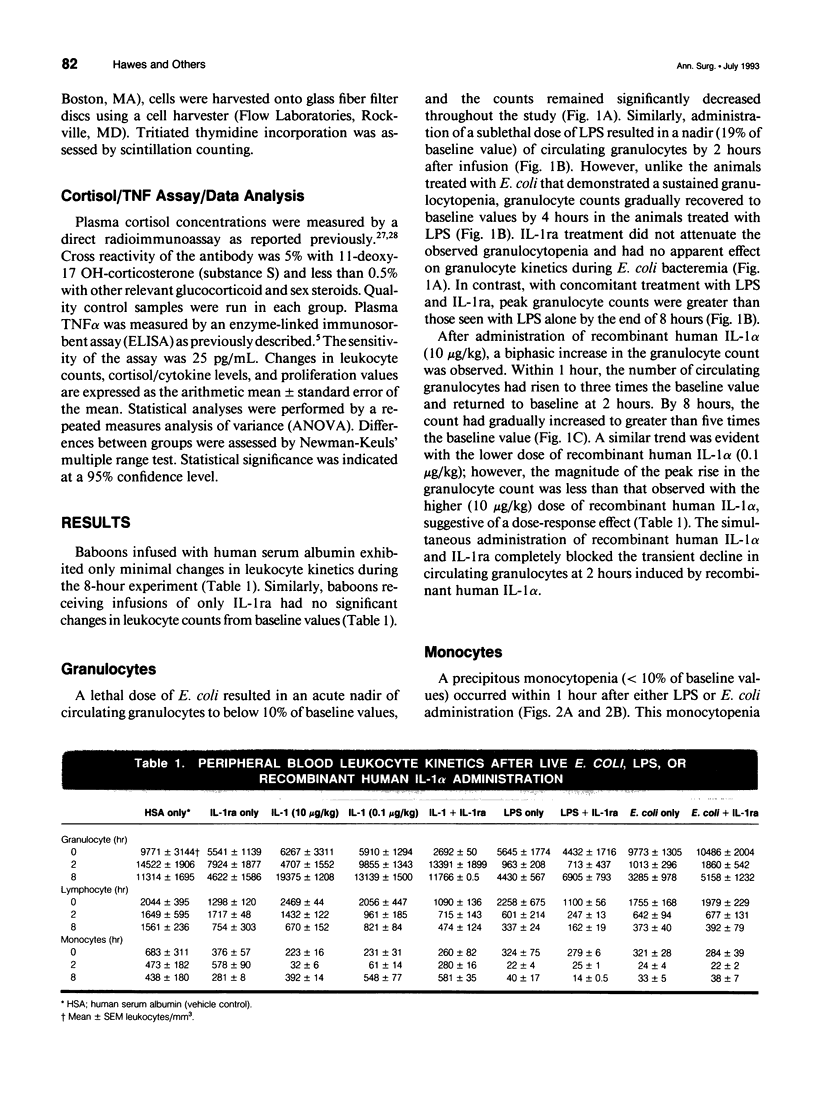
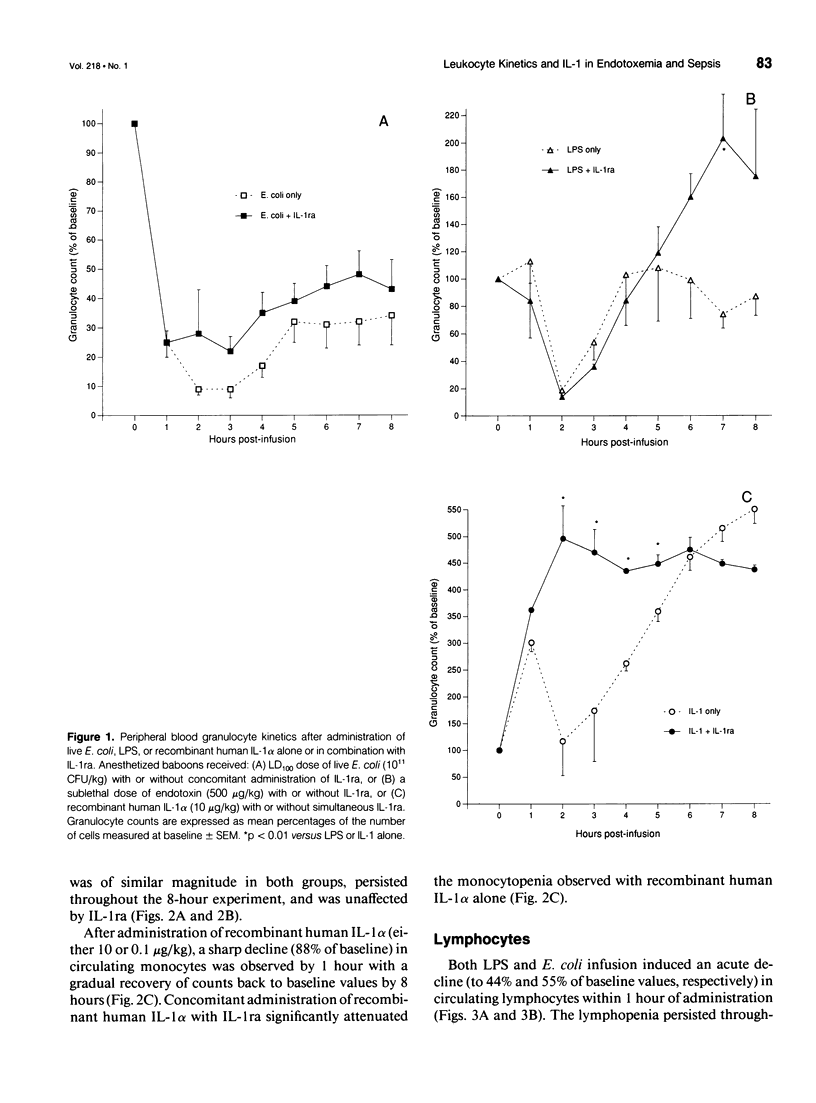
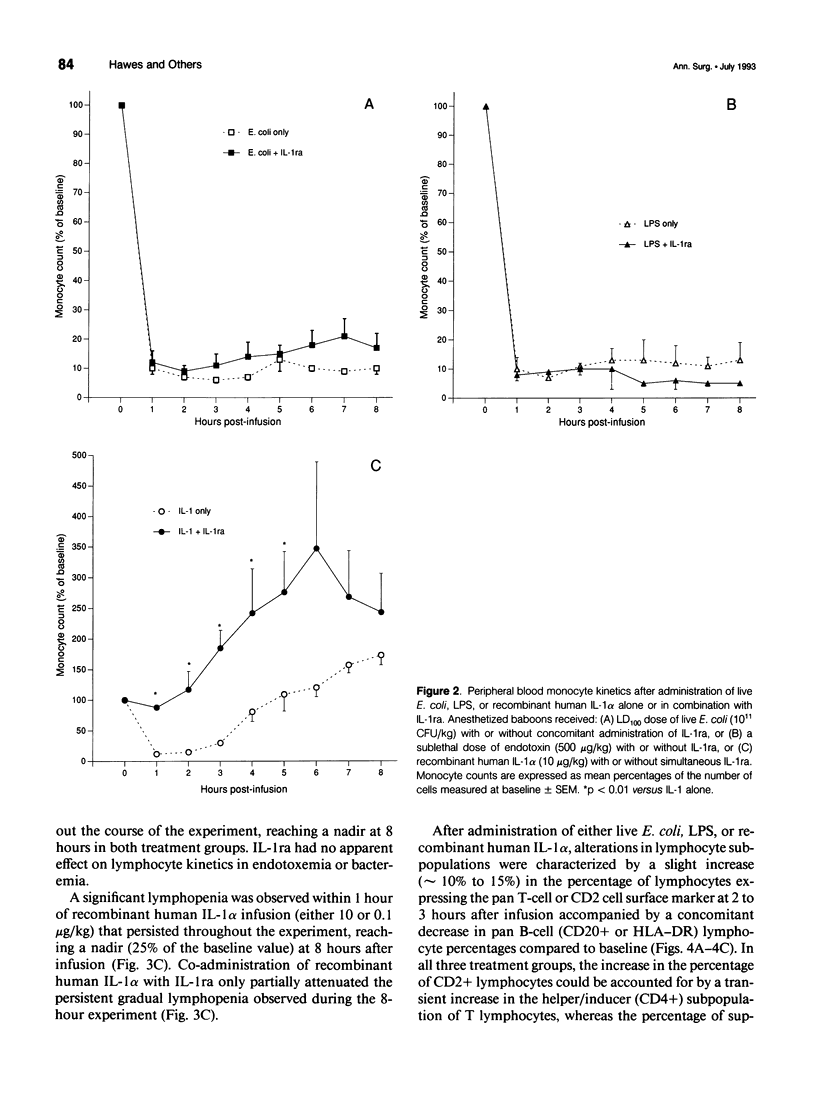
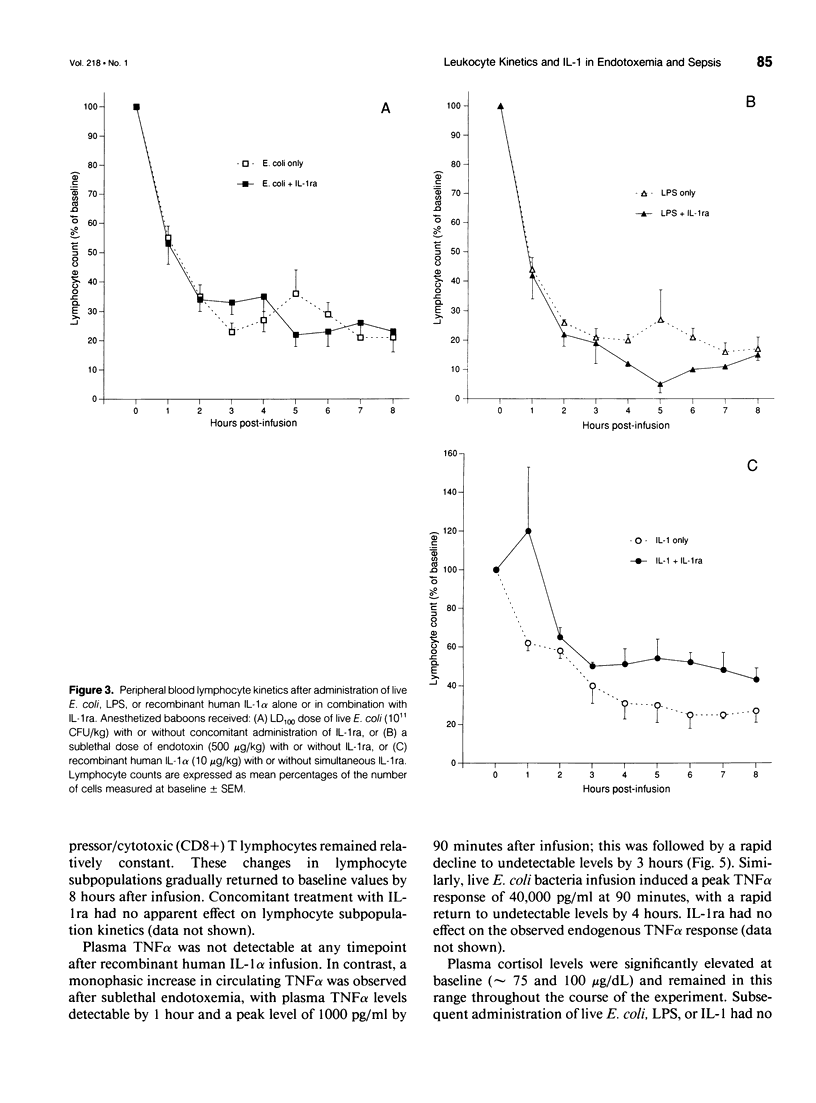
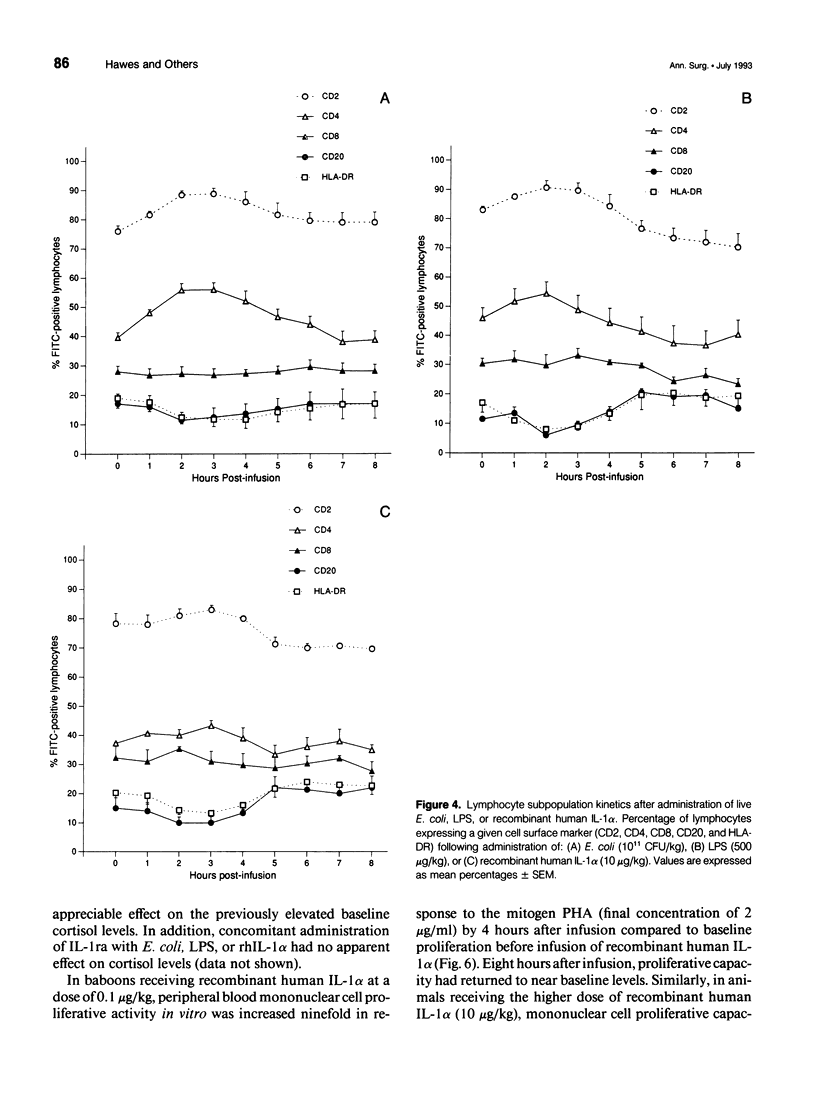
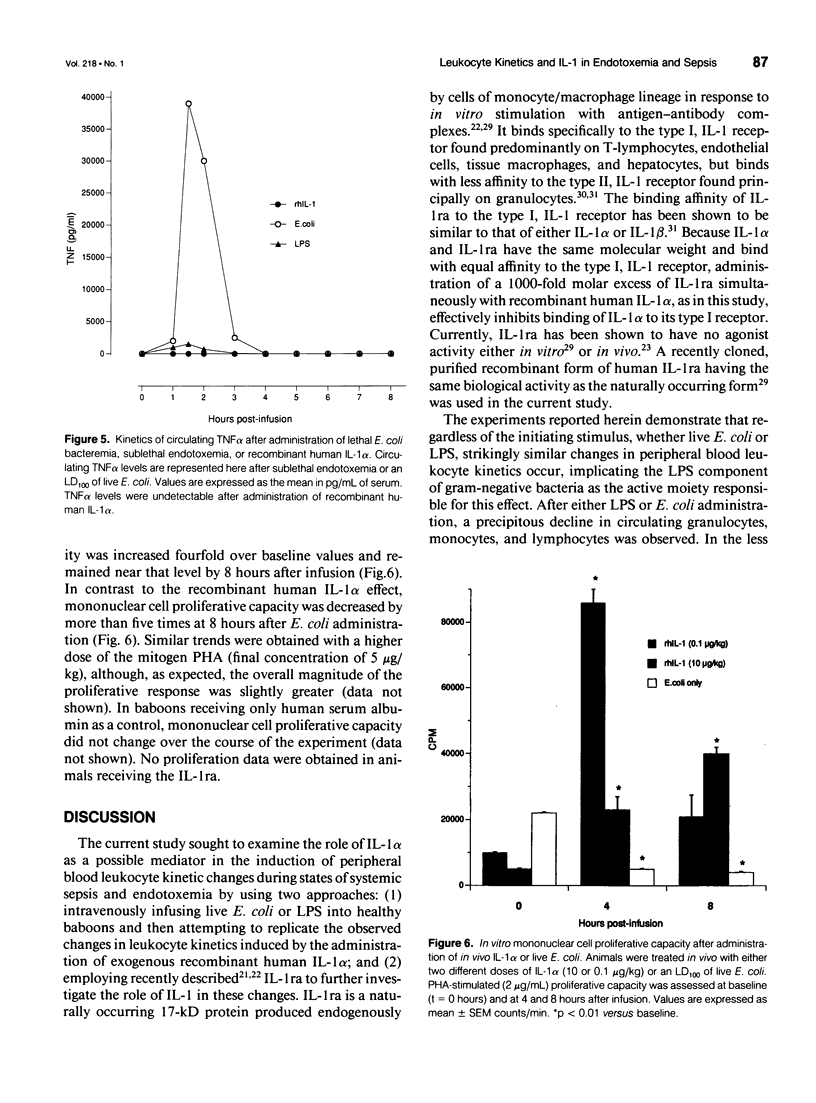
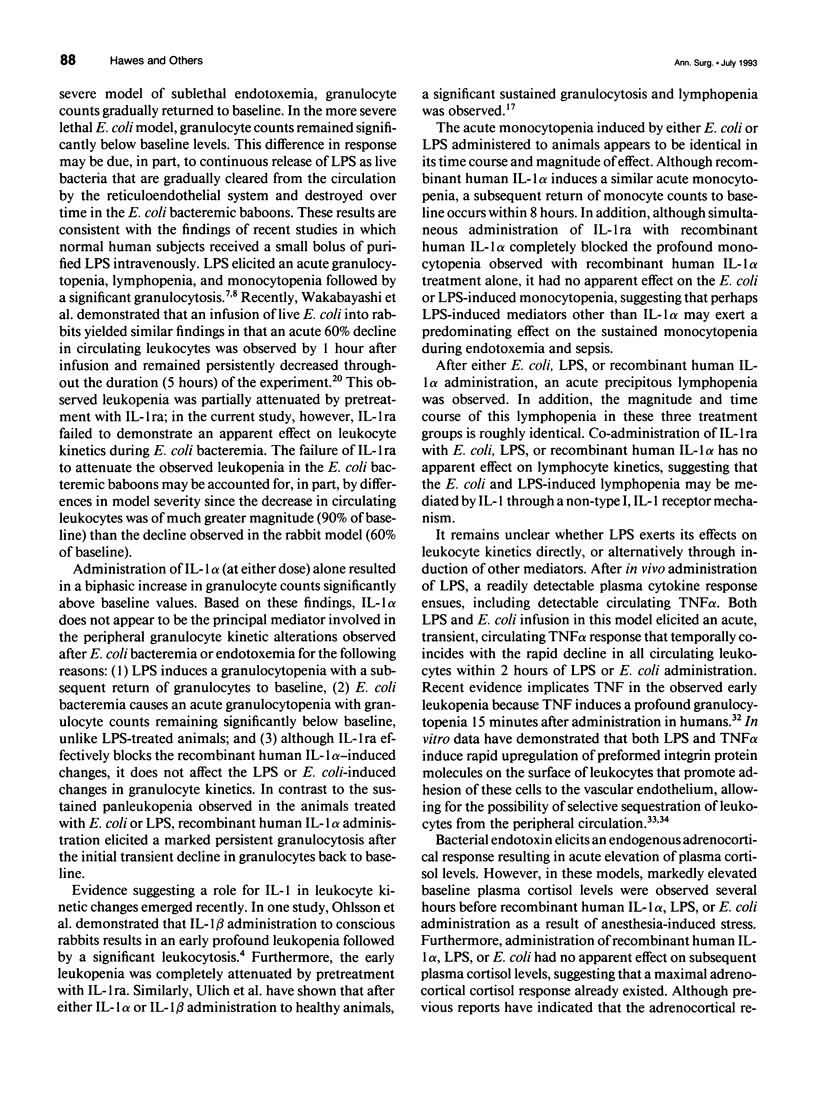
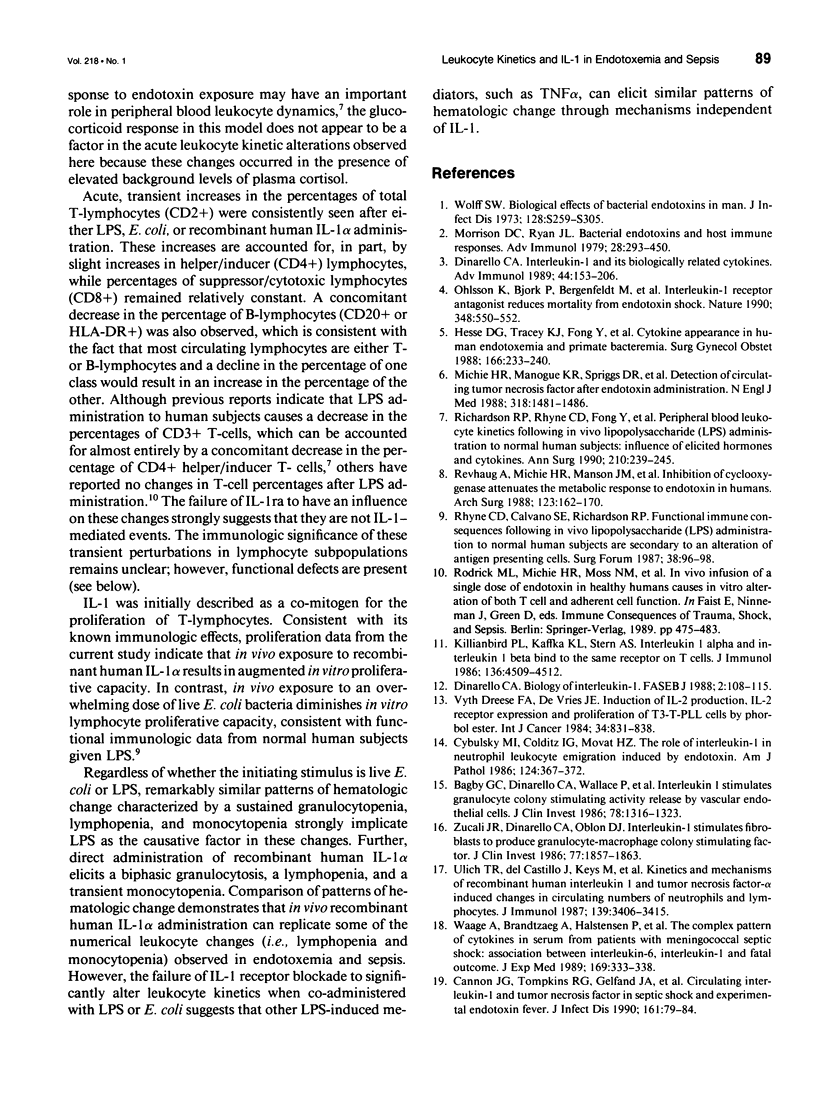
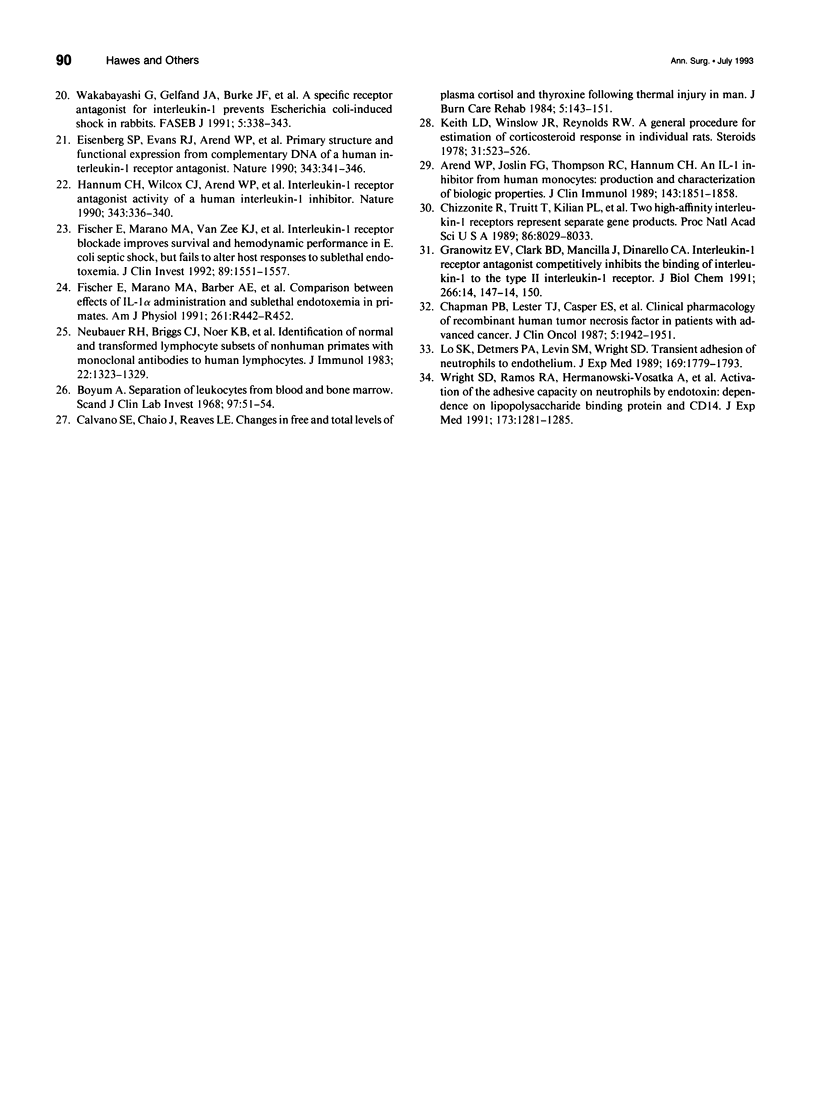
Selected References
These references are in PubMed. This may not be the complete list of references from this article.
- Arend W. P., Joslin F. G., Thompson R. C., Hannum C. H. An IL-1 inhibitor from human monocytes. Production and characterization of biologic properties. J Immunol. 1989 Sep 15;143(6):1851–1858. [PubMed] [Google Scholar]
- Bagby G. C., Jr, Dinarello C. A., Wallace P., Wagner C., Hefeneider S., McCall E. Interleukin 1 stimulates granulocyte macrophage colony-stimulating activity release by vascular endothelial cells. J Clin Invest. 1986 Nov;78(5):1316–1323. doi: 10.1172/JCI112717. [DOI] [PMC free article] [PubMed] [Google Scholar]
- Cannon J. G., Tompkins R. G., Gelfand J. A., Michie H. R., Stanford G. G., van der Meer J. W., Endres S., Lonnemann G., Corsetti J., Chernow B. Circulating interleukin-1 and tumor necrosis factor in septic shock and experimental endotoxin fever. J Infect Dis. 1990 Jan;161(1):79–84. doi: 10.1093/infdis/161.1.79. [DOI] [PubMed] [Google Scholar]
- Chapman P. B., Lester T. J., Casper E. S., Gabrilove J. L., Wong G. Y., Kempin S. J., Gold P. J., Welt S., Warren R. S., Starnes H. F. Clinical pharmacology of recombinant human tumor necrosis factor in patients with advanced cancer. J Clin Oncol. 1987 Dec;5(12):1942–1951. doi: 10.1200/JCO.1987.5.12.1942. [DOI] [PubMed] [Google Scholar]
- Chizzonite R., Truitt T., Kilian P. L., Stern A. S., Nunes P., Parker K. P., Kaffka K. L., Chua A. O., Lugg D. K., Gubler U. Two high-affinity interleukin 1 receptors represent separate gene products. Proc Natl Acad Sci U S A. 1989 Oct;86(20):8029–8033. doi: 10.1073/pnas.86.20.8029. [DOI] [PMC free article] [PubMed] [Google Scholar]
- Cybulsky M. I., Colditz I. G., Movat H. Z. The role of interleukin-1 in neutrophil leukocyte emigration induced by endotoxin. Am J Pathol. 1986 Sep;124(3):367–372. [PMC free article] [PubMed] [Google Scholar]
- Dinarello C. A. Biology of interleukin 1. FASEB J. 1988 Feb;2(2):108–115. [PubMed] [Google Scholar]
- Dinarello C. A. Interleukin-1 and its biologically related cytokines. Adv Immunol. 1989;44:153–205. doi: 10.1016/s0065-2776(08)60642-2. [DOI] [PubMed] [Google Scholar]
- Eisenberg S. P., Evans R. J., Arend W. P., Verderber E., Brewer M. T., Hannum C. H., Thompson R. C. Primary structure and functional expression from complementary DNA of a human interleukin-1 receptor antagonist. Nature. 1990 Jan 25;343(6256):341–346. doi: 10.1038/343341a0. [DOI] [PubMed] [Google Scholar]
- Fischer E., Marano M. A., Barber A. E., Hudson A., Lee K., Rock C. S., Hawes A. S., Thompson R. C., Hayes T. J., Anderson T. D. Comparison between effects of interleukin-1 alpha administration and sublethal endotoxemia in primates. Am J Physiol. 1991 Aug;261(2 Pt 2):R442–R452. doi: 10.1152/ajpregu.1991.261.2.R442. [DOI] [PubMed] [Google Scholar]
- Fischer E., Marano M. A., Van Zee K. J., Rock C. S., Hawes A. S., Thompson W. A., DeForge L., Kenney J. S., Remick D. G., Bloedow D. C. Interleukin-1 receptor blockade improves survival and hemodynamic performance in Escherichia coli septic shock, but fails to alter host responses to sublethal endotoxemia. J Clin Invest. 1992 May;89(5):1551–1557. doi: 10.1172/JCI115748. [DOI] [PMC free article] [PubMed] [Google Scholar]
- Hannum C. H., Wilcox C. J., Arend W. P., Joslin F. G., Dripps D. J., Heimdal P. L., Armes L. G., Sommer A., Eisenberg S. P., Thompson R. C. Interleukin-1 receptor antagonist activity of a human interleukin-1 inhibitor. Nature. 1990 Jan 25;343(6256):336–340. doi: 10.1038/343336a0. [DOI] [PubMed] [Google Scholar]
- Keith L. D., Winslow J. R., Reynolds R. W. A general procedure for estimation of corticosteroid response in individual rats. Steroids. 1978 Apr;31(4):523–531. doi: 10.1016/0039-128x(78)90034-x. [DOI] [PubMed] [Google Scholar]
- Kilian P. L., Kaffka K. L., Stern A. S., Woehle D., Benjamin W. R., Dechiara T. M., Gubler U., Farrar J. J., Mizel S. B., Lomedico P. T. Interleukin 1 alpha and interleukin 1 beta bind to the same receptor on T cells. J Immunol. 1986 Jun 15;136(12):4509–4514. [PubMed] [Google Scholar]
- Legaspi A., Roberts J. P., Albert J. D., Tracey K. J., Shires G. T., Lowry S. F. The effect of starvation and total parenteral nutrition on skeletal muscle amino acid content and membrane potential difference in normal man. Surg Gynecol Obstet. 1988 Mar;166(3):233–240. [PubMed] [Google Scholar]
- Lo S. K., Detmers P. A., Levin S. M., Wright S. D. Transient adhesion of neutrophils to endothelium. J Exp Med. 1989 May 1;169(5):1779–1793. doi: 10.1084/jem.169.5.1779. [DOI] [PMC free article] [PubMed] [Google Scholar]
- Michie H. R., Manogue K. R., Spriggs D. R., Revhaug A., O'Dwyer S., Dinarello C. A., Cerami A., Wolff S. M., Wilmore D. W. Detection of circulating tumor necrosis factor after endotoxin administration. N Engl J Med. 1988 Jun 9;318(23):1481–1486. doi: 10.1056/NEJM198806093182301. [DOI] [PubMed] [Google Scholar]
- Morrison D. C., Ryan J. L. Bacterial endotoxins and host immune responses. Adv Immunol. 1979;28:293–450. doi: 10.1016/s0065-2776(08)60802-0. [DOI] [PubMed] [Google Scholar]
- Neubauer R. H., Briggs C. J., Noer K. B., Rabin H. Identification of normal and transformed lymphocyte subsets of nonhuman primates with monoclonal antibodies to human lymphocytes. J Immunol. 1983 Mar;130(3):1323–1329. [PubMed] [Google Scholar]
- Ohlsson K., Björk P., Bergenfeldt M., Hageman R., Thompson R. C. Interleukin-1 receptor antagonist reduces mortality from endotoxin shock. Nature. 1990 Dec 6;348(6301):550–552. doi: 10.1038/348550a0. [DOI] [PubMed] [Google Scholar]
- Revhaug A., Michie H. R., Manson J. M., Watters J. M., Dinarello C. A., Wolff S. M., Wilmore D. W. Inhibition of cyclo-oxygenase attenuates the metabolic response to endotoxin in humans. Arch Surg. 1988 Feb;123(2):162–170. doi: 10.1001/archsurg.1988.01400260042004. [DOI] [PubMed] [Google Scholar]
- Richardson R. P., Rhyne C. D., Fong Y., Hesse D. G., Tracey K. J., Marano M. A., Lowry S. F., Antonacci A. C., Calvano S. E. Peripheral blood leukocyte kinetics following in vivo lipopolysaccharide (LPS) administration to normal human subjects. Influence of elicited hormones and cytokines. Ann Surg. 1989 Aug;210(2):239–245. doi: 10.1097/00000658-198908000-00018. [DOI] [PMC free article] [PubMed] [Google Scholar]
- Ulich T. R., del Castillo J., Keys M., Granger G. A., Ni R. X. Kinetics and mechanisms of recombinant human interleukin 1 and tumor necrosis factor-alpha-induced changes in circulating numbers of neutrophils and lymphocytes. J Immunol. 1987 Nov 15;139(10):3406–3415. [PubMed] [Google Scholar]
- Vyth-Dreese F. A., De Vries J. E. Induction of IL-2 production, IL-2 receptor expression and proliferation of T3- T-PLL cells by phorbol ester. Int J Cancer. 1984 Dec 15;34(6):831–838. doi: 10.1002/ijc.2910340614. [DOI] [PubMed] [Google Scholar]
- Waage A., Brandtzaeg P., Halstensen A., Kierulf P., Espevik T. The complex pattern of cytokines in serum from patients with meningococcal septic shock. Association between interleukin 6, interleukin 1, and fatal outcome. J Exp Med. 1989 Jan 1;169(1):333–338. doi: 10.1084/jem.169.1.333. [DOI] [PMC free article] [PubMed] [Google Scholar]
- Wakabayashi G., Gelfand J. A., Burke J. F., Thompson R. C., Dinarello C. A. A specific receptor antagonist for interleukin 1 prevents Escherichia coli-induced shock in rabbits. FASEB J. 1991 Mar 1;5(3):338–343. doi: 10.1096/fasebj.5.3.1825816. [DOI] [PubMed] [Google Scholar]
- Wright S. D., Ramos R. A., Hermanowski-Vosatka A., Rockwell P., Detmers P. A. Activation of the adhesive capacity of CR3 on neutrophils by endotoxin: dependence on lipopolysaccharide binding protein and CD14. J Exp Med. 1991 May 1;173(5):1281–1286. doi: 10.1084/jem.173.5.1281. [DOI] [PMC free article] [PubMed] [Google Scholar]
- Zucali J. R., Dinarello C. A., Oblon D. J., Gross M. A., Anderson L., Weiner R. S. Interleukin 1 stimulates fibroblasts to produce granulocyte-macrophage colony-stimulating activity and prostaglandin E2. J Clin Invest. 1986 Jun;77(6):1857–1863. doi: 10.1172/JCI112512. [DOI] [PMC free article] [PubMed] [Google Scholar]


